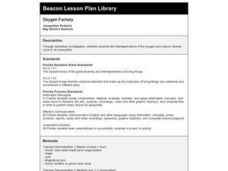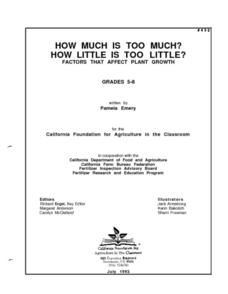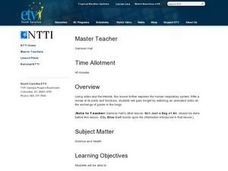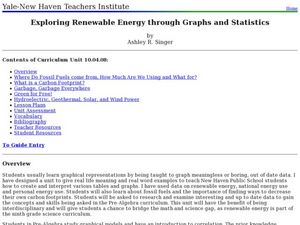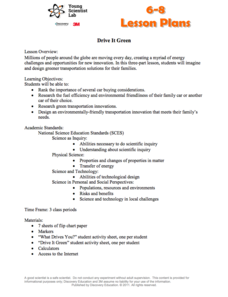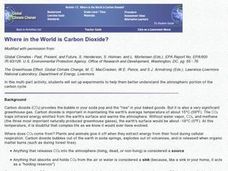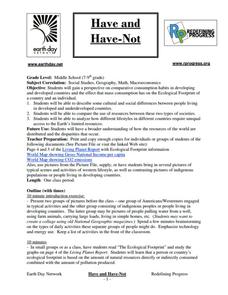Chicago Botanic Garden
Climate Change Around the World
Look at climate change around the world using graphical representations and a hands-on learning simulation specified to particular cities around the world. Using an interactive website, young scientists follow the provided...
Chicago Botanic Garden
Climate Change Around the World
You know climate change is happening when you see a bee take off its yellow jacket. Part four in a series of five lessons explores all factors affecting climate change: temperature, cloud cover, precipitation, and carbon dioxide. By...
Curated OER
Breathe In, Breath Out
Students discover how plants breathe. In this biology lesson plan, students learn that plants take in carbon dioxide and find that plants need sunlight to absorb the carbon dioxide.
Curated OER
Oxygen Factory
Fourth graders examine the interdependence of the oxygen and carbon dioxide cycle in an ecosystem through a laboratory investigation. After a lecture/demo, 4th graders complete the lab in groups.
Curated OER
The Living Environment
Students explore the cycles of an ecosystem. In this environmental science lesson, students work in groups to research the nitrogen cycle, the water cycle, or the oxygen-carbon dioxide cycle. Students prepare a PowerPoint or other...
Curated OER
How Much Is Too Much? How Little Is Too Little?
Students perform a series of experiments which show that plants require nutrients in certain quantities. They also cooperatively read materials on the nutrient requirements of plants, fertilizers, composting, and soil management, and...
Curated OER
Pop Rock Chemistry
In this pop rock chemistry worksheet, middle schoolers suck on pop rocks, they mix open pop rocks with water and they observe them on a paper towel with water. Students write down as many observations as they can and they write down as...
Curated OER
Blow It Up
Students observe an experiment. In this science instructional activity, students watch an experiment where baking soda and vinegar are used to blow up a balloon. Students answer comprehension questions about the experiment.
Curated OER
Rice Farming
Third graders investigate how farmers get more rice from their land. For this farming lesson, 3rd graders discover things that farmers to do produce more rice. Students study photosynthesis and illustrate pictures about it. Students test...
Curated OER
Is the Earth Warming? a Test of the Effect of Increased Carbon Dioxide on the Thermal Properties of Air
Students investigate the environmental and economic effects of increased carbon dioxide (CO2) content in the atmosphere.
Curated OER
CO2 Blow Out!
Fifth graders determine that carbon dioxide is a gas given off during respiration and that oxygent is the gas that is absorbed during respiration. They determine the air capacity of the lungs.
Curated OER
Global Warming
Learners analyze the effect of global warming given a set of data. For this ecology lesson, students evaluate the impact of excess carbon dioxide levels to living things. They watch a video then investigate the major points of the film...
Curated OER
Exploring Renewable Energy Through Graphs and Statistics
Ninth graders identify different sources of renewable and nonrenewable energy. In this math lesson, learners calculate their own carbon footprint based on the carbon dioxide they create daily. They use statistics to analyze data on power...
Discovery Education
Drive it Green
Explore and brainstorm innovations for cars with a STEM activity that asks scholars to weigh different options when considering when buying a car. They research the fuel efficiency and carbon emissions for various options, and then...
Curated OER
Where in the World is Carbon Dixoide?
Students conduct experiments designed to detect the presence of CO2 by using a BTB that changes color (blue to yellow) in the presence of CO2. First, students experiment with the CO2 from combining vinegar and baking soda. In part two,...
Curated OER
How Does the Loss of Ozone Affect Our Climate
Students explore the greenhouse effect and what it does to the environment. They discuss if and how human behavior contributes to global warming and test natural materials for carbon content.
Curated OER
Travel Solutions to Global Warming
Young scholars research and investigate the concepts carbon cycle and fossil fuels. They graph the carbon dioxide production as well as populations of six nations. Together they generate a variety of recommendations to reduce...
Curated OER
The Biomass Balancing Act
Pupils conduct research and prepare and share a fact sheet for biomass energy. They witness a demonstration illustrating the presence of carbon dioxide and design an experiment to investigate carbon neutrality.
Curated OER
Dry Ice: Simply Sublime
A fascinating lesson on states of matter is here for your young scientists. Dry ice is used to challenge learners preconceived notions about how solids work. They discover all sorts of interesting facts about states of matter from...
Redefining Progress
Have and Have-Not
Is there a correlation between a country's wealth and the extent of its ecological footprint? What exactly constitutes an ecological footprint, and how does one country stack up against the rest? This is a unique instructional activity...
Curated OER
The Cricket and The Plant
Students examine determine the symbiotic relationship between plants and animals as the find ways to naturally reduce carbon dioxide emissions. They study the carbon cycle. They work with probe and graphing calculator to examine the...
Curated OER
Take a Deep Breath: Air Today, Air Tomorrow
This is the introductory lesson in a series about air quality. Why is it so important that we breathe clean air? How can we make sure we're keeping our air clean? A discussion is the central idea of the lesson, and example questions are...
Curated OER
Mass-Mass Relationship
High schoolers investigate mass-mass relationships in the lab. In this mass-mass relationship lesson plan, students mix sodium carbonate with hydrochloric acid to produce sodium chloride, water and carbon dioxide. High schoolers use the...
Curated OER
Changing Planet: Fading Corals
Show the six-minute video, "Changing Planet: Fading Corals," and then demonstrate how calcium carbonate forms a precipitate in the presence of carbon dioxide. Separate your scientists into small groups to gather information about coral...
Other popular searches
- Carbon Dioxide Oxygen Cycle
- Carbon Dioxide Cycle
- Carbon Dioxide Balloon
- Co2 Cars
- Carbon Dioxide Levels
- Carbon Dioxide Emissions
- Experiments Carbon Dioxide
- Carbon Dioxide Detection
- Oxygen and Carbon Dioxide
- Trapping Carbon Dioxide
- Cows Carbon Dioxide
- Co2 Water Chemistry



